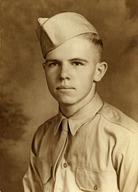
|

|
|
|
|
Edward was born in Shreveport, the only child of Louis Brun and Gussie Johnson Brun. His father, a native of Paris, France, who immigrated to America with his parents, worked for Kansas City Southern Railway for 42 years. Edward grew up in the Fetzer area where he enjoyed sandlot baseball and football. He also played flute in the high school band. The family owned a telephone so his father could receive calls from the railroad. They enjoyed listening to the radio. Meals consisted often of fresh vegetables from their garden. His mother dried beans and canned other vegetables in glass jars. They lived only two blocks from railroad tracks, and often fed "hoboes" who rode the rails. Edward graduated from Fair Park High School in 1942, studied one year in junior college, then began active duty on July 7, 1943 in the U.S. Army. He took basic training at Camp Grant near Rockford, Illinois. That training, he recalls, was only about a month. He was transferred to Fitzsimons Army Hospital in Denver where he trained three months as a dental technician. Edward sailed to New Caledonia aboard a Dutch vessel, MS Bloem Fontaine, arriving in spring of 1944. From there he soon joined the 52nd Army Field Hospital on Bougainville Island, where he worked first in the dental clinic before his transfer into a medical unit, where manpower needs were greater. Edward worked nights in a medical ward, where patients were being treated for diseases, not combat wounds. To correspond home, he used the quicker means of V-mail. Regular mail took two or three weeks for delivery, and airmail "a little less," he recalls. Packages often took a month or six weeks to receive. After nearly a year on Bougainville, he moved up with his unit to the Philippines, first on Mindoro, then Mindanao, where he helped set up a tent hospital in a coconut grove to treat battle casualties. Malaria also felled soldiers. "We took our Atabrine; we still had malaria to show up," he recalls. Flash floods from the mountains often sent water cascading into low-lying areas. Once, he saved two wounded men in body casts who almost drowned. Later the hospital moved to better quarters in a barracks in Davao. Meanwhile, Edward learned about current events from daily updates. "A news report of some type would come in and our office would mimeograph it and hang it on a tree somewhere and you could read what had come in from headquarters," he recalls. His diet ranged between Army chow and local foods. He really missed milk. "I saw no milk from the time I left San Francisco until the boat docked at Los Angeles bringing me home," he recalls. Edward supplemented his diet with fresh pineapples, coconuts, and bananas purchased from local Filipinos, whom, he says, were brutally treated by the Japanese. Many were hungry. "They said they were feeding their pigs. They were not feeding their pigs, they were feeding themselves," he says. Children often with distended bellies begged for scraps. "I think most of the men in my outfit always left a little on their plates, our mess gear, to dump into their buckets for them," he recalls. Edward heard about the war ending while he was on Mindanao. "There was a lot of partying. Everybody tried to find something to drink," he quips. He thinks the decision to drop the bombs was correct. An invasion against Japanese soldiers, and women and children armed with bamboo stakes, "would have been a disaster for us," he recalls. "It takes a lot of guts for a guy to cut somebody down that's armed with nothing but a fishing pole," he says. Edward was sent to Mindoro to a station hospital where he worked as a scrub nurse in a surgical unit "about three or four months." Coming home from overseas, his ship stopped at Pearl Harbor, where damage from the 1941 attack was still evident. He recalls a refreshing twist to his welcome to America at Los Angeles. "The first thing they did when we walked down the gangplank was hand us a glass of cold milk," he reports. Edward reached home in February of 1946 and "loafed around for awhile." He took classes at Centenary College, then earned a bachelor's degree in biology at Union College in Lincoln, Nebraska. On June 28, 1948 he married Faye Hendrick. They would have two children and three grandchildren. Edward earned a masters degree at LSU in microbiology, worked as a pharmaceutical salesman for 15 years, then taught science in Caddo Parish schools for 20 years, retiring in 1988. He and Faye traveled extensively, often in learning vacations. |


